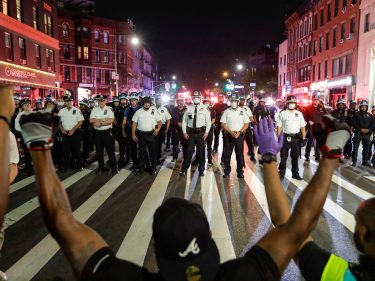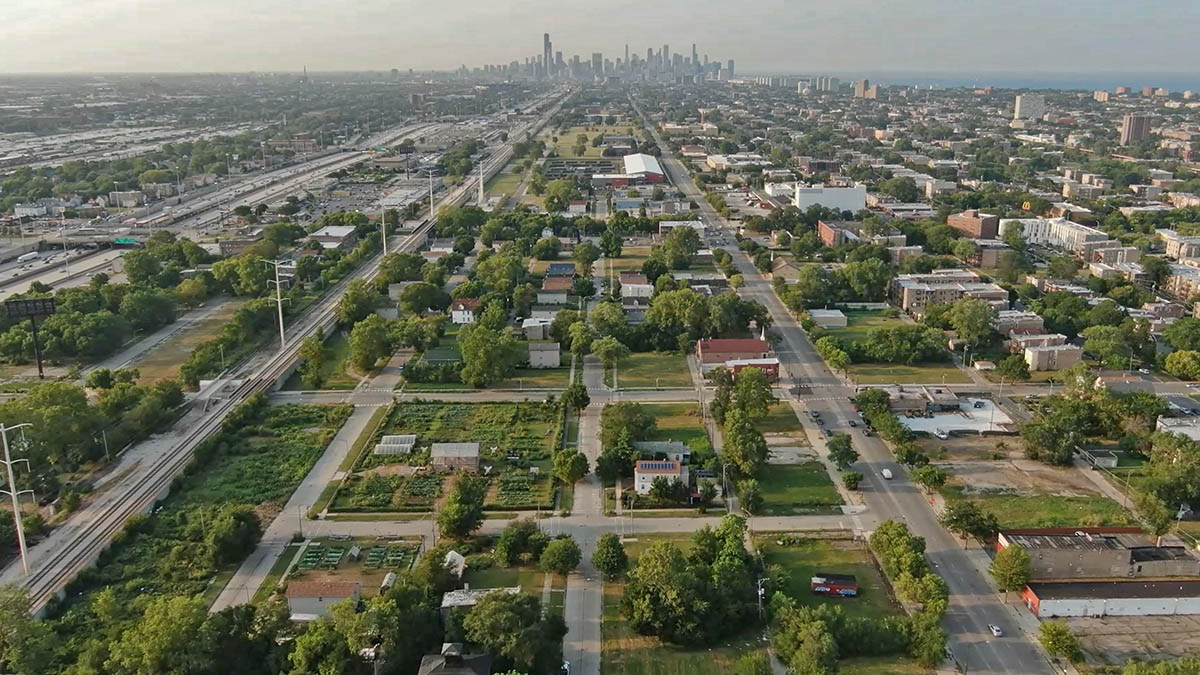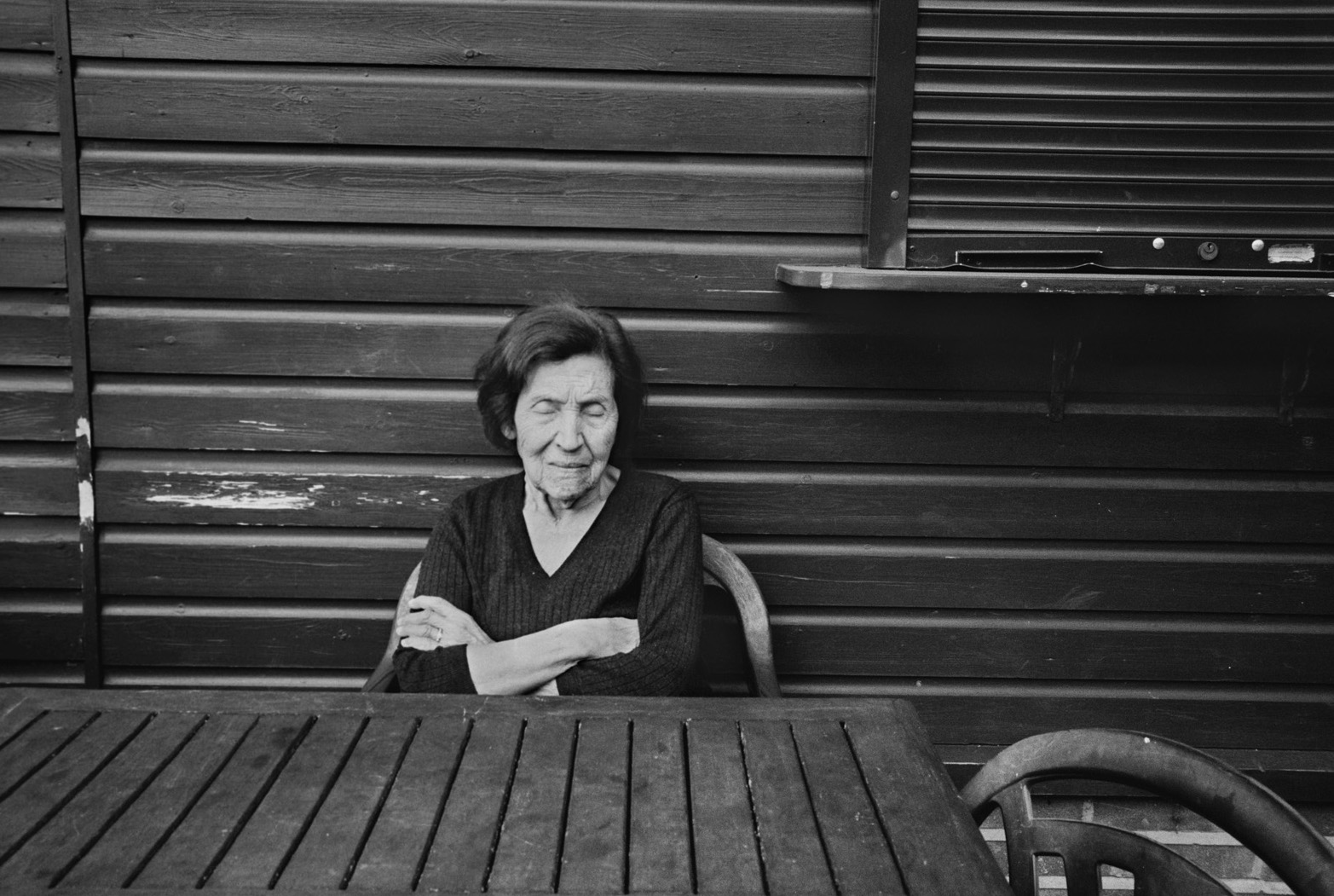Upward Immobility
Upward Immobility
The ideas, research, and actions from across Harvard University aimed at creating equitable opportunities for success and prosperity.
From the experts
The racial wealth gap may be a key to other inequities
A look at how and why we got there and what we can do about it.
Change of fortune
Members of the Harvard community are working to understand the roots of wealth inequality and what solutions could help create more equity for economic mobility and opportunity.
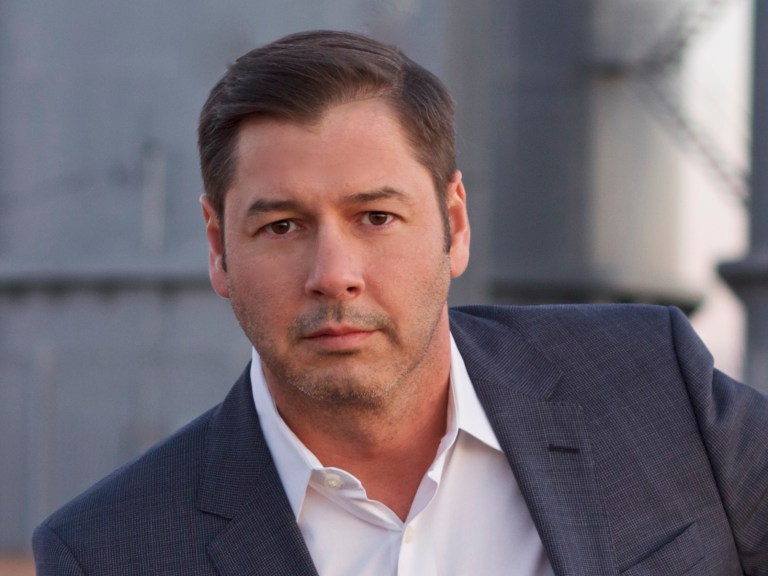
Podcast
In the people business
Harvard student and President and CEO of the National Center for American Indian Enterprise Development Chris James discusses the huge need for business infrastructure and entrepreneurship development in Native American communities.
Transcript
Jason Newton: Most Americans know, in a general sense, what a Native American Reservation is, and that groups of Native Americans were forced to move to them by the government of the United States throughout our country’s history.
Rachel Traughber: What you may not know is that many of these land tracts are among some of the most rural in the country – cut off from the U.S. economy and lacking in critical infrastructure and services. That reality is one factor which has led to high-poverty and limited business development opportunities for generations of Native people.
JN: Harvard Extension School student Chris James is working to change that. A former Associate Administrator at the U.S. Small Business Administration, he’s the President and CEO of the National Center for American Indian Enterprise, the largest Native American economic development organization in the United States.
RT: James has spent his life developing programs to help support the creation and growth of economic opportunity for Native Americans across the country. He joins us now to share more about his work with the National Center.
I’m Rachel Traughber, and I’m Jason Newton. And this is Unequal: a Harvard University series about race and inequality across the United States.
JN: Chris, welcome. And thank you for joining us. So I wanted to ask what drew you to working with small businesses and specifically Native American businesses?
Chris James: Well, thank you so much. You know, the biggest thing for me is I grew up in Cherokee North Carolina, on the Qualla Boundary, which is our reservation for the Eastern Band of Cherokee Indians. And my family for generations have had some type of small business commerce. I actually worked for my dad, in a in a small restaurant for years, my grandmother was a beader. And she had a she had a craft shop. So I, myself always had a passion for small business. And, and it was almost in my my blood. So that’s, that’s how I started working in small business. And then as I, as I continued to work on the reservation, I really got into economic development, and how can I support small businesses on the reservation was really important to me. And it just led to other opportunities in my life.
CJ: You know, there’s a huge need for business development in our Native American communities. Some of our communities are some of the most rural in United States, high poverty areas, and, and really lacks sometimes the infrastructure for business development because of the remoteness and ruralness of our communities.
JN: So you touched on the economic life on reservations all across the country, and it brings up the question for me personally, you know, can you explain some of the dynamics around what may have created such a concentration of poverty on Native reservations?
CJ: There has been hundreds and hundreds of years of relocation for our tribal communities. So for example, you know, a lot of the southeast tribes, majority of the southeast tribes were removed during the removal act in the 1800s. When those communities were moved from their existing homelands, oftentimes, they were put in a reservation community in an environment that they did not understand or even know. And it could be hundreds and hundreds of miles away from from their traditional homelands. So the traditional hunting and the traditional farming and all the things that that community had done for thousands and thousands of years, all of a sudden, that community is in a totally different environment, with totally different land and totally different types of hunting and environments. So that I think started it.
A second piece of that is the reservation system were often in very rural areas. So the ruralness, the isolation was also a factor to to high poverty in in those areas.
And then lastly, a lot of those communities were totally reliant on federal government. And unfortunately, with the overload over reliance on the federal government, there wasn’t the infrastructure development to foster businesses and to to create a system of entrepreneurship and communities.
Now, a lot of that is changing. And it has been changing for the past 20 to 30 years. Part of that is, is some of our communities, not only develop gaming enterprises, but they developed other types of business enterprises that actually support economic development and support their community. And then second, over the past 20 or 30 years, there’s also been increase support for entrepreneurship development. And organizations like myself, we really focus on that individual entrepreneur, helping them develop businesses and create jobs in the community and, and really foster an environment of success. And we also help the tribes do the same. What type of businesses can a tribe create, to, to help support the community and help bring in not only revenue for the community, but also jobs.
RT: You’re president and CEO of the National Center for American Indian Enterprise Development. Tell us a little bit about the Center. What is it and how did you become involved?
CJ: The National Center is a nonprofit organization that focuses on business enterprise development in Native American communities. The Center’s been around since 1969. It’s a 50-year-old organization. And really, it has supported billions of dollars worth of contracts to Native American businesses, including tribally owned businesses, through various types of procurement. We’ve also helped foster an ecosystem of entrepreneurship through training and technical assistance to our Native American business owners. And we’ve also supported thousands and thousands of job creation in Indian Country.
My involvement of the National Center was that I left the federal government in 2016. And and I left Washington DC, with the desire to get back to my roots. And my roots were what is economic development in Native American communities. So I felt like I could help continue the growth of the National Center. I laid out a five-year strategic plan to really focus on those core core tasks of developing businesses. We also started focusing on access to capital, and we’ve developed a Native CDFI that launches this year. And we really bolster a pipeline to support Native youth so that they can be prepared to start businesses when they’re ready. We also work with Fortune 500 companies, to help with their supply chains, and to bring in more Native American businesses in their supply chain, or into their workforce.
RT: Chris, I’m wondering if you could share with us what are some of the unique challenges that come with running a business on a reservation?
CJ: You know, Rachel, I think some of the unique challenges of running a business on a reservation is one, oftentimes, because of the overall remoteness of our reservation communities. You know, there’s, there’s not the normal commerce, like oftentimes, there’s no banking, you know, there’s, there’s no, if you need to get supplies, there’s not a Costco for your business. So a lot of times, just overall distance is a hindrance, you may have to drive two to three hours to get to a more urban market.
Last week, I was in rural Alaska. And I was in a village called Kiana, and Kiana is north of the Arctic Circle. It’s a village of about 300 people, the only way into the village is, is by plane. And the overall infrastructure and a community like that, how do you do commerce? How do you even get goods? You know, the closest bank is 1000 miles away. So how do you? How do you do commerce? And, and I think that, that leads to some unique, unique challenges, but also a wait, you know, out of the box, thinking of how to build and grow businesses in rural American and reservation and rural communities. So, you know, the unique the unique challenges are infrastructure, the banking system, sometimes lack of technology or internet, and then even sometimes lack of a workforce, or even customers.
RT: So Chris, you know, the story about you going to Alaska and being close to the Arctic Circle really brings home to me the understanding that there is a wide variety of tribal nations that you have to work with on a regular basis. You know, there are 574 federally recognized sovereign tribal nations across the United States. Each has their own custom, their own culture, their own economic needs, given this variety, this diversity, the fact that they’re so specific to their locations, and those different needs, how do you approach creating or customizing programs at a national level that can reach as many people as possible?
CJ: Rachel, that’s a great question and and the National Center we spend a lot of time listening to our community members and our business owners to try to understand the unique situations we have. We have clients from Alaska all the way to Florida, all the way to New York. And each one of those clients they do, they, they are like you, like you said, you know, they’re they’re all different different communities, different infrastructure. So possibly working with a community in Alaska is is very different than working with a community in Oklahoma. And and those businesses are often different as well. So our general approach is, you know, developing us a system, where we’re able to provide a lot of individual support. So we don’t really have, you know, we don’t do like a one fit all approach. Every time we develop a program, we run training programs, every month, we do webinars every other week, we customize that program for that particular community or that particular state, even oftentimes. So when we do a training in Alaska, it’s very customized to Alaska, and we do our own research and our own listening sessions, so that we meet the needs of the businesses in that community. So we’ve done, we did an event in the Carolinas, also about a month ago. And again, those needs of those businesses and what type of training those businesses wanted, was very different than what we’ve done in Northern California. So making sure that we listen, and then help develop a program that those those businesses are those tribes, you know, will be, will be very beneficial, helping them helping develop a program that’s very beneficial to the community.
JN: So you touched on, you know, some of the various challenges, you know, that affects what may or may not be successful. Can you maybe point to some of the success stories, like what types of businesses are successful, or sustainable in terms of revenue?
CJ: There’s thousands of different types of businesses out there that the tribes themselves have created to help bolster economic development, that also includes the gaming industry. But surprisingly, the gaming industry is a very small percentage of, of overall revenue, a very small percentage of the tribes actually rely on gaming, probably about 80% of the tribes actually have to have some other type of revenue in their communities.
Secondly, for the entrepreneurs, they’ve created businesses, from large construction companies to hospitality and retail, to arts and entertainment type businesses as well. So there, there are hundreds of different types of businesses on reservation communities, and a lot of those businesses are really doing well. Of course, COVID, has taken a huge impact in our communities all over the United States, but specifically in Native American communities, but our businesses are resilient. And, and they, you know, they are looking to grow and change and, and, you know, build economies in their community.
JN: That actually touches on a question that I wanted to bring up, you know, you mentioned COVID-19, and how it dramatically affected businesses on reservations, you know, businesses in the United States and globally, have also been affected drastically by the pandemic. So the businesses that you support, how did they fare overall throughout the pandemic? And and what’s the method of recovery from, from this as we start to hopefully, pull out of the pandemic for good?
CJ: Yeah, well, you know, we definitely can’t gloss over the realities of what COVID has done. all over the United States, but specifically in Indian Country. Nationwide, our casinos, a lot of our casinos closed their doors, oftentimes, in in many of those areas, that was the only employer. You know, the casino was one of the only employer not only for the reservation community, but also the trickle effect surrounding communities. And so you’re talking about almost a billion dollars, just in lost wages, from having the casino revenue closed up. So that that revenue when the businesses are closing, and then the tribal businesses are closing, that means that there’s a loss of jobs, a loss of of tax revenue in some areas. You know, and just, you know, just a lot of loss because of that one particular business.
For our small businesses, the National Center partnered with the Federal Reserve Bank of Minneapolis to do a business survey, and this was about a year ago. So a lot of the businesses and the businesses are still struggling, but about 68% of our businesses have seen at least a 20 to 40% revenue reduction nationwide. And then also, for that revenue for those tribally owned businesses, some of those tribally owned businesses have had an 80% loss and that is you Mainly because of just just closures.
So you can see that that that impact. You know, we all of us see the impact throughout the United States, I mean, everything that we do every day. But then if you add the, you know, rural community, if you add high poverty in, in these areas, that impact is, is even higher. And, and some of those businesses are really small, small businesses. In fact, we found, like one in six businesses have said that they are just not even able to get back open. And that is something that the National Center has really been working hard on how can we help our businesses diversify? And how can we help them get back in operation, and what other support is out there to keep those businesses going? So we did a lot of support on on PPP programs in the SBA restaurant revitalization program. So a lot of like, information, and helping our clients apply for those funding sources.
RT: That actually leads me into my next question for you, which is, how can people listening today be supportive of native business?
CJ: I think, you know, folks that are listening today really need to understand the diversity of, of what our native communities are. And, and actually, there are a lot of opportunities for those companies, you know, for people to you know, diversify their workforce and diversify their supply chains and add more vendors that are from the Native American communities. We have so many businesses that are not only doing government contracting, but they’re working with with large companies like Lockheed Martin and Boeing. So, you know, there’s a lot of opportunities, folks should not forget that, that Native American businesses are out there. And that they’re very, they’re very diversified businesses.
A second piece is, you know, there’s lots of opportunity to make impact investments into the Native American community. That could be looking at opportunities directly supporting Native community development, financial institutions, that could be looking for opportunities to, you know, connect with an actual tribal enterprise, and, and develop the commerce on a reservation.
And then lastly, there’s also the ability to have mentors and leadership development. So folks that that might be listening to this, there’s those type of opportunities. They can reach out to organizations like myself and say, How can we support if we want to be a mentor? Or maybe we have, you know, a curriculum development to help support businesses? How can we how can we donate some of our time to help support Native American infrastructure? There’s lots of nonprofits out there like myself that that, you know that that can be a resource for your listeners.
JN: That was Harvard Extension School student Chris James, President and CEO of the National Center for American Indian Enterprise Development.
RT: If you liked what you heard, and want to learn more about Harvard’s Unequal project, visit us online at harvard.edu/unequal.
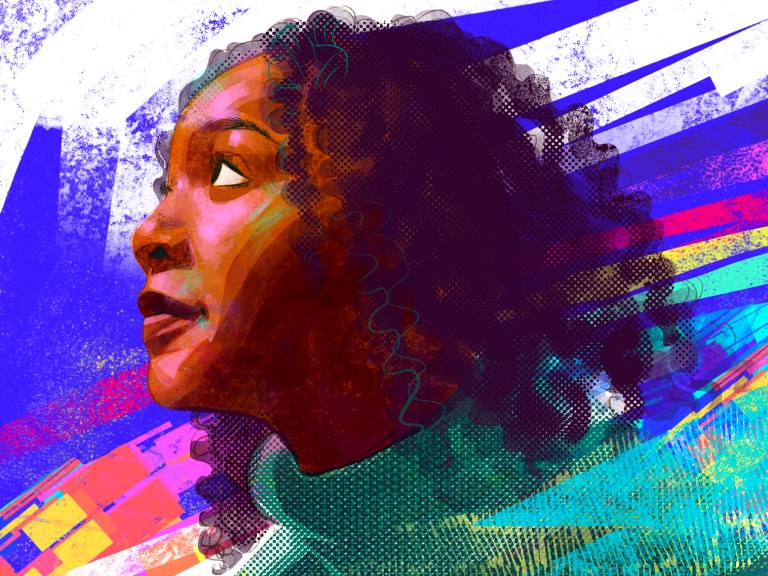
Personal essay
Christina Cross
“What we need are policies that alleviate financial hardship and facilitate good, consistent parenting,” says the postdoctoral fellow and assistant professor (beginning 2022) in the Department of Sociology at Harvard.

Video
Change is collective
Harvard alumna Sarah Lockridge-Steckel is co-founder and CEO of The Collective Blueprint, a nonprofit organization that provides pathways to opportunities for young adults through partnerships with education institutions and employers in her hometown of Memphis, Tennessee.
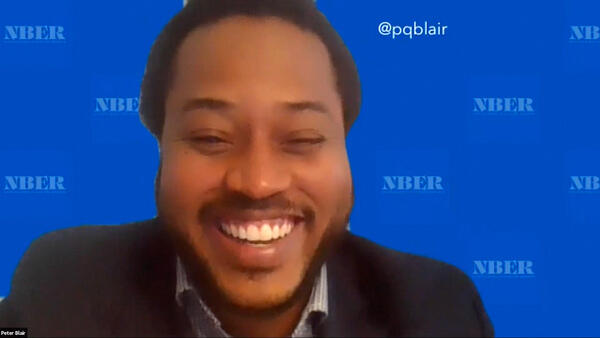
5 BIG IDEAS IN INEQUALITY SERIES
The racial wealth gap
In this entry of the Malcolm Wiener Center for Social Policy video series “5 Big Ideas in Inequality” experts explore the causes of, and solutions to, the racial wealth gap.
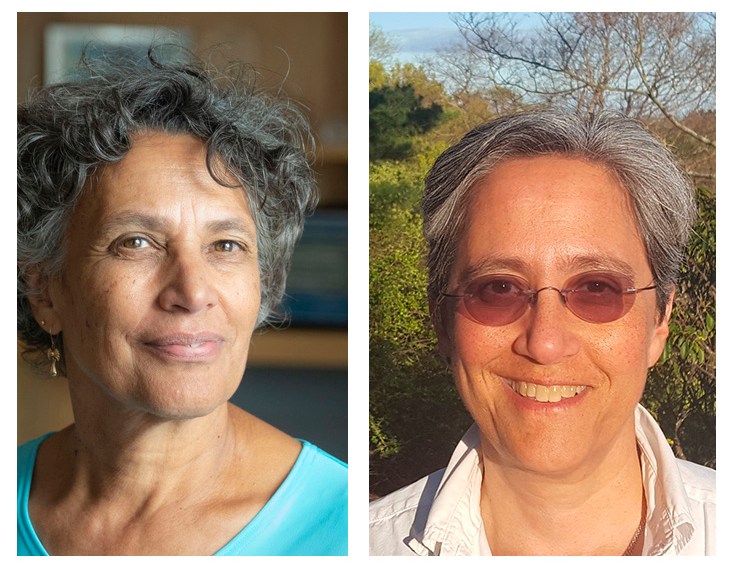
Podcast
Health and housing
Transcript
Rachel Traughber: It has been nearly a century since the Homeowners’ Loan Corporation was established, and the creation of its infamous “Residential Security” maps of nearly every major American city.
Jason Newton: Those maps may not be familiar to you, but you’ve probably heard of the term the maps invented — Redlining, an official government policy that institutionalized housing discrimination against Black families and other minorities across America.
RT: We spoke to Dr. Nancy Krieger and Dr. Mary Bassett — both from the Harvard T.H. Chan School of Public Health — about the devastating effects of this racist policy that are still being felt to this day, and how they reinforced the structural racism leading to a litany of poor health outcomes for minorities. Many that were exacerbated, tragically, during the Covid-19 pandemic.
JN: I’m Jason Newton
RT: and I’m Rachel Traughber. And this is Unequal: a Harvard University series exploring race and inequality in the United States.
RT: Professor Bassett, let’s start with the basics. What is redlining, and why is it important to understand in a health context?
Professor Mary Bassett: Well, redlining is shorthand for a policy that emerged and was promulgated principally by government after the Great Depression in the 1930s, when something called the Homeowners Loan Corporation was established to help government insure mortgages and make mortgages more available to the public. It used to be that you had to have a huge share of the purchase price before you could buy a house, but that went down to just 10% when government stepped in to help guarantee mortgages.
And in order to help accelerate this program, they gave guidance in the cities where redlining became prominent. They gave guidance on what areas were mortgage-worthy areas. And they literally coded them with red ink around the communities that would not be considered eligible for these government insured loans.
And that is where the word redlining comes from. Because literally, the borders of these communities were outlined in red ink. And the strategy included an assessment of the racial composition of that neighborhood. So that high credit risk neighborhoods were ones that were predominantly Negro, as people of African descent were called then. So, neighborhoods that were black neighborhoods were redlined. And the people who live there would not be eligible for, for these loans would become victim to predatory private lending that charge exorbitant rates for mortgages and not eligible for homeownership at all, which, of course, is one of the principal assets that underlies the intergenerational transfer of wealth.
JN: And did that track well with the neighborhood that you grew up in, in Washington Heights, you said on the border of Harlem, which, obviously is a historically African American community and Washington Heights being largely Latino community?
MB: Yeah. Well, when my parents bought their house, they discovered that the community had been redlined. And they had a great deal of difficulty obtaining a mortgage. And it turned out, in the end, that it was a small bank that was headquartered in Puerto Rico, where the bank manager was able to take the chance on my father, who was a university professor, to make… lend my parents money to buy their house. So redlining was historical, and persisted, even after the Fair Housing Act should have overturned it. So, we see the impact of redlining that affected my family personally, yes.
RT: So, when you’re thinking about the implications of this for, for people’s health, what exactly is the connection between a policy like redlining that was set up in the 30’s, and is maintained in some ways today, and health? Where does that connection happen and what does it look like?
MB: Well, I think of redlining as one of the key examples of structural racism. And by structural racism, I mean, the type of racism that works without individuals expressing prejudiced opinions, because it’s embedded in the way institutions work. And this case, it was embedded in the way the banking industry worked. It was embedded in how realtors valued homes and markets; it’s embedded in the way private homeowner organizations set up private covenants that excluded black people from their neighborhoods. All… multiple institutions engaged in achieving residential segregation.
Now, what did that mean for health? Well, basically, these communities became multiply disinvested in… Redlining kind of set up a platform for neighborhood deprivation, from everything from the amount of tree cover, to the availability of retail food outlets, to the safety of the streets. All of these, it turns out, are factors that affect our health, and they’re often referred to as the social determinants of health.
And structural racism is really antecedent to the social determinants of health. It’s what explains why people of African descent are disproportionately poor, have low levels of educational attainment, have access to health care that may not be of high quality, live in neighborhoods where there has been public disinvestment and private disinvestment. All of those social determinants of health have a lot to do with how healthy we are. And of course, it includes access to health care.
RT: Professor Krieger, you and your colleagues have studied the health effects of redlining to two states – specifically, cancer rates in Massachusetts and, along with Professor Bassett, preterm birth rates in New York. There have been a few other studies of different health conditions in other redlined areas: Why did you pick these two particular states for the two studies you conducted?
Professor Nancy Krieger: So, just to be very clear, there’s currently only 13 published studies in the literature on historical redlining and health, which have used various study designs. It’s still a very new area of research… for having… and looking at that in relation to contemporary health conditions, and the studies vary widely in their methodology and also what the outcomes are. So, I think it’s really important to frame what our work was that we’ve already published as part of a very new, truly nascent literature, that’s beginning and there are lots of discussions that are methodologic that are really important about how you actually figure out what the right ways are to divvy up the population data in relation to these past historical boundaries which don’t neatly map onto current census boundaries, for example, for census tracks, block groups, or even blocks.
NK: I say that because there’s a lot of scientific rigor that goes into these studies and work that is being figured out. What you need to have to do this kind of work and to do it properly is individual health records that you can geocode to their block level so that you can make sure you’re attributing people correctly to the right redlined area, because you have to superimpose the redlined areas on to contemporary geographies, that gives you the population counts that you need to compute rates. We’re not just looking at cases, we’re looking at rates which is the number of cases per population per area per unit time.
So, from that standpoint what we needed is what to have access to these data and we went to two places that we knew we could do this. We’ve worked extensively for many years, my team and I, with the Massachusetts Cancer Registry, and what we looked at was actually the… what was going on with regard to the stage of diagnosis for cancer, and we chose that because we… our rationale for choosing cancer stage of diagnosis is that really does depend on your current circumstances. It’s not about the etiologic period – that is, how long it takes to get from whatever the exposure is to the actual diagnosis of cancer – it’s about given that you’ve got this process going on in your body at what point is it captured, and that refers to conditions in the here and now that can be plausibly linked to contemporary conditions of both not only what your own household economic circumstances are, but also the access to transportation and to healthcare facilities, and the many other things that go into the actual access to health care for being diagnosed with cancer.
So we specifically chose cancer stage diagnosis and we looked at it for Massachusetts because we had access to the Massachusetts Cancer Registry data at the individual level for many years which our team geocoded, and as part of our practice we return all vehicles to the cancer registry so they’re able to allow other people to also use the geo codes that we assigned to the cases, because all the registry has – like any entity that works on medical records – is the actual address, and you have to convert the address into geo codes that can be assigned in a geo referenced way to a map, and then also again allocated in relation to contemporary population counts for the denominators but also the boundaries of the red line and other areas that were designated by the Homeowners Loan Corporation or HOLC.
Similarly for New York City, that’s one of… that’s the largest city in the U.S., it’s incredibly an important location, and we also were because of our good relations with the New York City Health Department or… or Department of Health and Mental Hygiene. We were able to get access to their birth records and also do the geocoding and do the linkage to the HOLC maps at that time. And so… in one sense these are quote unquote “convenience samples” because we had the necessary collegial relations with the health departments and the cancer registry to do this research, but also, one start somewhere, and simply to dive into a national analysis, well, that would be a little difficult in terms of getting all the individual level health records that you need to geocode each individually to be able to do this kind of work properly.
RT: What did your studies find in those two cities?
NK: In brief, both studies showed the importance of historical redlining in combination and also independent from contemporary census tract conditions that people live in where historical redlining does set up the people who live in those areas for worse health outcomes in our studies defined strictly in relation to risk of premature birth, and also in relation to late-stage cancer diagnosis, especially for lung cancer for men and for breast cancer for women.
JN: Professor Bassett, you talked about structural racism, and the health effects of structural racism are obviously complex and often come with a variety of factors, be it economic, or social, etc., that complicate responding to them directly. But given this complexity, what would a public policy solution to the health effects of living in a redlined neighborhood look like in your opinion?
MB: Well, there are a whole host of correctives and we’re seeing some of them under the banner of what’s being called “reparations.” But basically, it should involve the reinvestment in communities that have been disadvantaged by bad policies for decades. And not only helping individual families but reinvesting in the public infrastructure of these communities, and, of course, there are also people who make the case for individual reparations for people of African descent, who were the victim, not only of redlining but of centuries of uncompensated labor.
So, I think that structural problems need structural solutions, and I’m glad that we’re beginning to see, you know, some of those raised and some jurisdictions seeking tend to take them.
JN: And the thinking a lot of times when it comes to, to big public policy is that the states are kind of like the “test labs” for policy. Do you know of any examples from America, in particular, where any of this has been tried before? Can you give us any examples of what successful public health policy might look like to help combat this history of entrenched racism and inequality?
MB: Well, of course all of the… the whole host of legislation in the mid 1960’s, under the general heading of the Great Society were… that whole bunch of legislation, the Civil Rights Act, the Fair Housing Act, the Voting Rights Act, as well as other efforts, tackling the environment, and so on. All of these were associated over time, with a decline in premature mortality. This is work that Nancy Krieger and her group published a couple of years ago, when we have a better policy environment – a more equitable and more democratic policy environment – we see the rates of premature mortality go down, and we see the racial gap in premature mortality narrow. And that’s what her analysis showed.
It’s pretty striking. I didn’t know until I read her paper, for example, that it wasn’t until the mid 1990’s, that black men in this country achieved a stable life expectancy of 65 years, meaning that that life expectancy hadn’t gone down below that, again. That was achieved in the 40’s and 50’s for the white population, and also much earlier for black women.
So, you know, better policies are reflected in lower mortality rates, and it should be a source of worry for all Americans, regardless of their race, that the United States is now experiencing a decline in overall life expectancy, one that began before COVID, but clearly will be accelerated by the COVID-19 pandemic, which in many ways really displayed lots of the effects of structural racism that we’ve been talking about.
JN: Absolutely, yeah, we all see that play out just really on a daily basis over this past year. It’s been really interesting and tragic at the same time. So, it sounds like you see this as a top-down problem that was created by government policy in particular. So, do you believe that it must be corrected through top-down government policy as well? Or is there any space at the city, state, local level? Or should this be something at the federal level where they have the most resources and can implement it across all 50 states?
MB: Well, clearly the federal government had a key role to play in, in establishing redlining as a driver of residential segregation. That wasn’t the only driver, but it was a key one and government has an obligation at the federal level to correct it. That said, of course, there are opportunities at local and state levels to adopt policies that are pro equity. And I wouldn’t say that anyone should give up, that all efforts are needed. But an important lesson from history is that government policy helped drive these inequities. This was not the result of simply 1000 private prejudices. This was the result of concerted and intentional government policy.
So, I am… and by that, I mean federal government policy. So, I think we need action at all levels. And certainly, when I was in New York City, an example of an action that the De Blasio Administration was taking was the implementation of a universal pre-k program. There’s lots of evidence that investing in early childhood is one of the most cost-effective interventions that we have. If we get the early years right for children, they are well set to withstand adversity in the years to come. So that would be an example of something that can be done, you know, within a city or within a state. But ideally, it really should be done nationwide. Our whole nation has borne the brunt of these bad policies, and we need federal action to fix them.
RT: Professor Krieger, if people are interested in learning about redlining and health in their own backyard, maybe even in their own city, where can they go to find out more?
NK: Yes. I mean there are two websites that I would definitely recommend where you can play around and see if your own city… One that comes from the University of Richmond is called “Mapping Inequality Redlining in New Deal America,” and that gets you right into what all the digitized maps are as well as what the notes were that accompany the ratings for each of the neighborhoods. And then they’ve most recently produced a new website that’s called “Not Even Past: Social Vulnerability and the Legacy of Redlining.” And what this does is gives a digitized display of the trajectories of areas in terms of what they were for their HOLC grades, to what their contemporary social and economic conditions are. And they again include some health data that I would just offer some caveats about, but nevertheless, they’re there, and you can start to look at them.
There’s also a very important report that was issued in September 2020 by the National Community Reinvestment Coalition, called “Redlining and Neighborhood Health.” That report is available on the web. There is a great video, which gives you a national sense, which is based on the book by Rothstein, Richard Rothstein, his book is called “The Color of Law: A forgotten history of how our government segregated America,” that was published in 2017. And the video, which is freely accessible and about 17 minutes, is called, “Segregated by design,” And it’s a wonderful introduction to the horrors of racialized economic segregation as wrought by historical redlining, due to the actions of the US federal government.
RT: Again that was Dr. Nancy Krieger, professor of Social Epidemiology and director of the HSPH Harvard T.H. Chan School of Public Health Interdisciplinary Concentration on Women, Gender, and Health.
JN: And Dr. Mary Bassett, director of the FXB Center for Health and Human Rights and professor of the Practice of Health and Human Rights. Both are in the Department of Social and Behavioral Sciences at the Harvard T.H. Chan School of Public Health. If you are interested in what you heard and want to learn more about Harvard’s Unequal project, visit us online at harvard.edu/unequal.
Harvard professors Mary Bassett and Nancy Krieger discuss the devastating health effects for people living in the shadow of redlining, a historic government policy that institutionalized housing discrimination against people of color across America.
Where we’re focused
These are just a few of the initiatives Harvard Schools have created to take on these important issues.
The Tulsa Massacre
A new Harvard Business School case by Mihir Desai examines the Tulsa Massacre of 1921, and asks difficult questions about what reparations America owes to its Black citizens.
The exhibition
“Think about all of the promise and the wealth that could have been passed from generation to generation to generation,” said Oklahoma Representative Regina Goodwin.
The podcast
Harvard Business School professor Mihir Desai discusses the arguments for and against reparations in response to the Tulsa Massacre and, more broadly, to the effects of slavery and racist government policies in the U.S.
The free educational guide
A guide to help students consider the issue of reparations generally, how it applies to the Tulsa Massacre, and how it applies to the effects of slavery and racist governmental policies in the U.S.
Juneteenth
Racial inequality around wealth and opportunity in America can find its roots all the way back at the end of slavery, with its still unseen promise of “… absolute equality of personal rights and rights of property between former masters and slaves.”
A time of reckoning
Juneteenth marks the day when federal troops arrived in Galveston, Texas—two and a half years after the end of the Civil War—to emancipate people who were still living in bondage.
Explore the series

Unequal
“Unequal” is a multi-part series highlighting the work of Harvard faculty, staff, students, alumni, and researchers on issues of race and inequality across the United States.
Unequal- Environmental Exposure
Finding solutions to climate change, pollution, and environmental contamination for all communities.

- Democratic Deficits
Exploring the inequality in our democratic institutions and representative elections.
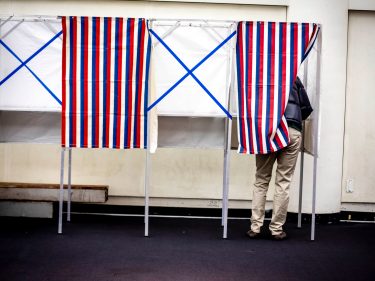
- Criminal Injustice
Creating a more equitable criminal justice system.
